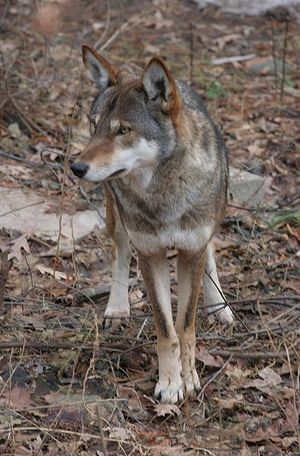The wolf. Canis lupis. Oftentimes the center of legends and myths as the ‘big bad’, wolves have gotten a bad rap, which they do not deserve at all. But no matter your opinion on the wolf, everyone has heard of them and many of us live with their descendents: the domesticated dog, the closest resemblance of which is shared between German shepherds and malamutes.
After being hunted nearly to extinction on false claims and completely inaccurate portrayals, the gray wolf is making a comeback in the Great Lakes area, the Northern Rockies and southwestern United States, to name a few places.
And let’s not forget to mention that they have also survived the ice age. The wolf is a tough, intelligent predator that can be found all over the world.
General Description
The gray wolf is a large, highly intelligent carnivore (meaning that they are meat-eating predators) that lives in a pack society. They, contrary to their name, can come in many colors, including solid white, black, cinnamon, brown, gray and combinations of those. At the shoulder wolves generally range from 26-32 inches tall or .7-.8 meters, and from nose tip to the end of the tall, they average 4.5-6.5 feet or 1.4-2 meters. In terms of weight, most wolves fall somewhere between 55-130 pounds or 25-59 kilograms. In general, male wolves are bigger than the females in terms of weight and height.
But that doesn’t mean they can’t be larger than that. The biggest gray wolf ever recorded in North America weighed in at a 170 pounds or 79 kilograms and was killed in east-central Alaska on July 12, 1939. The heaviest wolf recorded in Eurasia was killed in the Kobelyakski Area of the Poltavskij Region, Ukrainian SSR. It weighed 190 pounds or 86 kilograms.
The farther north a wolf pack is, the larger the members tend to be, and reversely so in the south (the farther south, the smaller), as is true of most animals.
Lifespan
In the wild, wolves typically live between eight and ten years of age. However, it is not unusual for wolves of around thirteen years of age to be seen in the wild.
In captivity, the oldest wolf lived to be seventeen years old.
Diet
Wolves are primarily carnivores, which means that they eat meat and are hunters. Although, they never pass up a free meal, making them scavengers. If another animal has died of sickness, old age, or for some other reason, a wolf won’t hesitate to eat it.
Their usual diet consists generally of ungulates (animals with hooves), such as deer, elk, caribou, etc. These animals are hard to kill, however, and wolves will eat anything they can catch and kill, including beavers, squirrels, mice, rabbits, birds, and even fish.
In the truest sense of labeling a wolf’s diet, one should call them an omnivore, as most wolves will eat anything they can catch and kill or find. This includes vegetables and fruit, particularly berries.
Unlike some animals, wolves never cannibalize their own young; however, they have been known to eat adults of their species in harsh winters and times of starvation, generally those that have died or are too weak to live. It should be noted that should they eat a wolf, it is generally a wolf not belonging to their pack.
Wolves hunt in groups (their packs) and generally hunt cooperatively to bring down large animals, which are dangerous to the wolves. They have been known, however, to kill animals such as bull moose and elk in an one wolf hunt. This not the norm though.
Gray wolves rarely attack anything that they do not intend to eat, which is why there are so few incidences of wolf attacks on humans. However, wolves are wild animals and are known to attack out of fear or self-defense. They should never be treated as one would treat their pet dog.
Habitat
Gray wolves can survive in many different places as long as there is sufficient food and the climate is closer to cold than warm. An example of one of the habitats best suited to wolves is the Siberian Taiga, a boreal forest with long, (very) cold winters and shorter summers. It is located in Russia where wolves have the greatest numbers.
In addition to this, all wolf packs defend a territory, which varies greatly in size due to many factors. These include pack size, number of wolves in the area, the density of prey in the territory, etc.
Once common throughout North America, most were killed off in the mid-1930s, resulting in a much reduced range that includes: Canada, Alaska, Idaho, Michigan, Minnesota, Montana, Wisconsin and Wyoming. In 1995 wolves were reintroduced to the United States, and Yellowstone National Park is now one of the most favored places to see a wolf in its natural, wild habitat.
Classification
All animals have a classification and wolves are no different. They are classified in the following way:
Kingdom: Animalia
Phylum: Chordata
Class: Mammalia
Order: Carnivora
Family: Canida
Subfamily: Caninae
Genus: Canis
Species: lupus
And all that basically means that wolves are animals who also happen to have a spine, are warmblooded, eat meat, and are mammals of the canine family.
Gestation and Pups
A wolf reaches sexually maturity at the age of one for females (though they never mate in the wild until the age of two) and the age of two for males. Usually the alpha male and female are the mating pair.
Wolves mate once a year between the months of January and March. The female has a gestation (or is pregnant for) approximately 60-63 days. The average litter is around four to six pups, but it can be smaller or much larger, depending on how harsh the winter is and how available food is. Litters of up to seventeen pups have been recorded. These are rare.
Pups are born in a den and are completely reliant on their mother and their pack. They are born defenseless, deaf, and blind, and weigh about one pound. They stay in the den for about two months, leaving occasionally to play outside after about the first month, and the mother takes care of them. She is brought food by other members of the pack, usually the father. During this time, the puppies eyes change from the blue of pups to the golden yellow-brown color of an adult and they gain sight and hearing. Their eyesight begins to develop around nine to twelve days after birth. They begin the process of eating solid food about one month after birth.
Most of puppies growth occurs in the first fourth months. During this time they may grow up to thirty times their birth weight.
Wolves are monogamous, meaning that they mate for life. If one half of the pair dies, the wolf will find a new partner. They are not incestuous.
Older females will generally give birth in the den they gave birth to their last litter in while younger females will tend to make their dens near their own birthplace.
Behavior
Wolf behavior is so complex that it could take several articles just to explain. For brevity’s sake, it can be condensed into the basics.
Wolves are very similar to dogs in their behavior. They live in pack structures (compare this to your family) headed up by the alpha male and female (mom and dad). It consists of their current litter, pups and younger members of previous litters (siblings), and other subordinates (grandpa, grandma, aunt, uncle, cousin, etc.) Depending on territory size and food availability, the pack size varies. A pack averagely consists of four to seven members, but packs of up to thirty-six animals have been recorded.
They develop intense bonds with each other and are very family-oriented. The entire family pitches in to feed and protect pups, and they are known to help provide for their elderly members who are unable to hunt as well as they used to.
After a kill, the alpha male and female eat first, and then the rest of the pack, depending on rank. They will eat the same kill until it is gone.
Wolves spend their entire lives working – and playing – together. This results in a tight-knit family who follows orders very effectively. Wolves enjoy such games as you might see your pets playing, including ‘tag’, ‘fetch’ and wrestling with one another, even as adults. As pups, this is an important part of growing up. It teaches coordination, strengthens the muscles, and helps them when they are old enough to hunt.
They are highly territorial, clearly marking their boundaries and challenging any trespassers. They are often very dangerous and aggressive toward members that are not part of their pack and other animals, such as bears or foxes, that encroach upon their kill or pups.
Communication
Wolves have a complex communication system comprised of many vocals and a lot of body language. While it is true that wolves howl, they do not howl at the moon; however, on a lighter night, they will howl more often, giving the impression of howling at the moon. They also bark, whine, whimper, growl, and make other vocal communications.
Body language is perhaps more communicative than their vocals. They use it to coordinate hunts, show affection, and to show respect, as well as communicate in general. A subordinate wolf will fold its ears back and tuck its tail in between its legs to show submission. They may even lay down and roll over, exposing their stomach to their alpha, whereas alphas carry their tail high and keep their ears up to show their dominance.
An aggressive wolf will also have its tail raised and its fur standing on end to make it look bigger than it is with its teeth bared.
A wolf that wants to play will act just like your dog when it wants to play: by thumping its front paws on the ground and wriggling its rump in the air, bouncing around you excitedly.
Wolf communications can be very much so correlated to that of the domesticated dog.
Domestication
Wolves have been domesticated. They are called dogs now. Or canis lupus familiaris.
The dog was domesticated 15,000 years ago, though some studies suggest that they branched away from wolves even sooner than that.
Domesticated wolves, unlike dogs, respond much better to hand signals and positive reinforcement rather than voice commands and the threat of punishment if they misbehave.
Status as a Species
Wolves are listed as endangered under the Endangered Species Act (ESA) throughout the United States, excluding Idaho, Montana, and parts of Washington, Oregon and Utah. In Minnesota, they are only listed as threatened, and in Alaska, they are not listed at all.
The U.S. Fish and Wildlife Service removed the northern Rockies gray wolf on May 4, 2009, from the endangered list. That means up to two-thirds of the wolf population in that region can be killed. Of the approximately 1600 wolves there that would leave only 450 wolves approximately. Many are against this. For instance, the Defenders of Wildlife and other conservation groups are actively taking part against it. For more information, see this website.
Threats
The biggest threat to wolves is humans. In the wild, they have no real natural predators and more often killed by their pray or starvation than other predators – except humans.
One of the biggest problems is humans lack of understanding of these creatures and a deep, misguided fear of them.
Another problem is human encroachment into their territory, which leads to even more fear and the possibility of wolves eating livestock. This occurs because, a)humans take or scare their food off; b)livestock is easy prey and is often improperly guarded against wolves; and c)wolves only understand their own territorial boundaries and if the livestock is on their territory, it is, in their minds, free game. There are solutions to keeping wolves from attacking livestock that do not involve shooting the animals, such as proper fencing, dogs of the shepherd variety, and keeping dead, sick and dying animals away from the others.
SOURCES
“Gray Wolf – Canis Lupus – Defenders of Wildlife.” Defenders of Wildlife – Protection of Endangered Species, Imperiled Species, Habitats. Web. 06 July 2010. http://www.defenders.org/wildlife_and_habitat/wildlife/wolf,_gray.php>.
“Gray Wolf – Canis Lupus.” Blue Planet Biomes. Web. 06 July 2010. .
“Gray Wolf.” Wikipedia, the Free Encyclopedia. Web. 06 July 2010. http://en.wikipedia.org/wiki/Gray_Wolf>.



